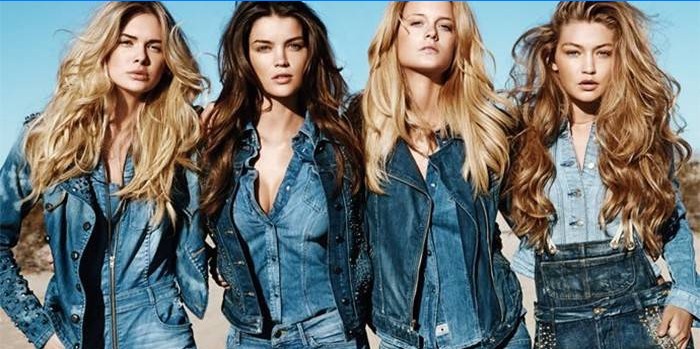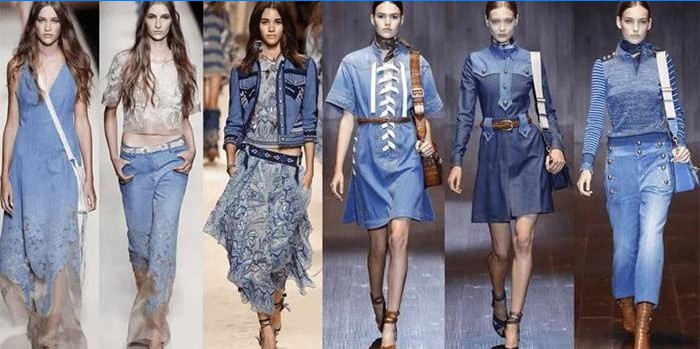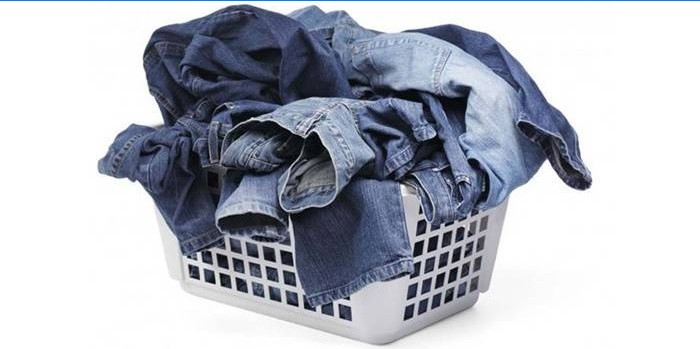The content of the article
- What is denim
- Denim style
- Appearance story
- The composition and properties of the fabric
- Varieties of material
- What is sewn from denim
- Advantages and disadvantages
- Denim Care
Natural cotton fabric, which is used to create comfortable, practical elements of wardrobe, shoes, and accessories, is called denim. The original purpose of the material is the manufacture of clothing for ordinary workers. Later, fabric gained popularity, and now denim jeans clothes can be found on almost every person – trousers, skirts, jackets, sundresses or sneakers. Bestsellers are Levi’s and Wrangler.
What is denim
The dense coarse twill weave, on which you can see the scars and tubercles, is called denim. A feature of the material is the appearance: the “face” is a light blue or blue hue, and the wrong side is white. It is widely believed that denim and denim are one material with different names, but it is not. The first option is made from twill. Denim is created on a natural cotton basis with the addition of stretch threads.
Denim style
Convenience and practicality are the main features of denim style. Denim outfit is suitable for walking, dating, picnic, going to the beach. The main thing is to choose the right length, color, other elements of the image, accessories. Flared jeans, pipes help hide the flaws of the figure, riding breeches are suitable for owners of ideal proportions. If in doubt, you can choose the option that suits any addition – this is a classic style of straight cut. Denim color depends on the season: in summer and spring – light shades, for winter and spring – restrained dark colors.
When choosing elements of jeans clothes, the main thing is not to overdo it: a lot of materials of the same type do not make the image harmonious. The choice of a denim jacket depends on the style and the rest of the clothes: short models are worn on the dress, with small drawings all over the fabric (bananas) or in one place (flowers on the shoulders) for a street fashionista, a denim with many locks, rivets and a large pattern on the back for biker style. The shirt should be free, you can tuck it in trousers to give “negligence”. Dresses are better to choose a free cut.
Not only denim jeans (denim jean) are made of fabric, but also shorts, dresses, shirts, vests, jackets. The advantage of style is versatility: denim pants can be combined with tops, blouses, t-shirts and shirts. Any shoes are suitable: sneakers, pumps, heels, sandals, boots. Accessories are selected depending on the idea of the image: these are bright belts tied to the hips or neck of scarves, chains. Dressing of the fabric occurs by applying acrylic paint, embroidering drawings, patches or inserts from another material.

Appearance story
Denim begins its history with 19th-century America. Levy Strauss and Jacob Davis (entrepreneurs) during the Gold Rush in the country imported material for the manufacture of canvas and used it for rough trousers for American workers. Later, businessmen launched the production of pants, while using soft textiles from the French town of Nimes. After that, the name of the fabric “denim” appeared, which means “brought from Nimes”.
The composition and properties of the fabric
Denim consists of natural cotton called Gossypiumbarbadense and is made in the USA, Egypt and Turkmenistan, as it requires special agricultural technology. The most high-quality technology for creating fabric is considered to be selvage (on shuttle machines, where it is processed, and a seam). Denim can consist of different types of cotton, additives and have the appropriate properties:
- Cotton from Mexico Uplandcotton is used to produce smooth jeans. This is due to the fiber length (up to 2.5 cm).
- Cheap cotton from Zimbabwe is a substitute for raw materials, which provides an opportunity to offer products to customers at different prices.
- Cotton from India and Asia is part of the most inexpensive products.
- Cotton from the USA ExtraLongStaple (Memphis, St. Josim Veli, Mississippi, St. Louis brands) is used to make premium denim.
- Cellulose is used for the strength of cheap fabrics..
- To impart color, the material is dried at least 10 times and dipped in dye.
Varieties of material
Denim is in its pure form (coarse cloth) or with additives used for certain purposes (to make a thing warmer so that it rests on the body). Impurities of the canvas determine what kind of textile will be the result:
- Chambray (Chambray). The fiber is made of thin threads, designed for summer clothes, sewing shirts and dresses.
- Gin. The budget plain fabric obtained from polyester, viscose replaces most of the cotton. Gin weaving diagonal.
- Stretch The fabric is obtained by adding elastane and serves to fit denim to the body and adjust the silhouette.
- The warmed option. Demi-season denim fabric is obtained by attaching tales, fleece, and other dense fabric to the inside. Combines materials dublerin or interlining.
- Summer “breathable” things come from adding silk.
What is sewn from denim
A common denim product is pants. At the same time, the versatility of the material allows you to create many wardrobe items:
- Jackets
- vests;
- shirts;
- shoulder products;
- skirts;
- shorts;
- shoes (sneakers);
- linens;
- hats;
- bags;
- other accessories (shawls, belts).

Advantages and disadvantages
Denim fabric is found in the wardrobe of almost every modern person. This is understandable: things from the material have several advantages:
- universality – with the right combination, you can wear a denim thing for any reason;
- wear resistance, strength – the right material can be worn for more than one year, denim is durable;
- the breathable properties of tissue pass air to the body, but do not allow dust to freeze or penetrate, the material is hygroscopic;
- the fabric is not electrified;
- multiple variations of the use of fabric – manufacturers make denim pants, shorts, skirts, dresses, shoes, accessories, other wardrobe items;
- comfortable comfortable clothes.
Cons of fabric products are also available. They are explained by the natural composition of the material:
- slow drying after washing;
- after improper washing, the fabric sits and becomes stiff;
- material fading over time.
Denim Care
Denim material may sit down after washing, deteriorate when ironed, and fade. To avoid unpleasant consequences, you must adhere to the rules for the care of the fabric:
- Before washing, you need to fasten buttons, locks, rivets, all metal, the thing itself is turned inside out.
- Denim can be washed manually or using a machine, while the powder should be without a bleaching effect (there will be blue granules in the white mass).
- Before washing, soak clothes for no more than half an hour, while the powder is diluted in water, and not sprinkled on a thing.
- If there are lumps of dirt on the fabric, it is better not to use a brush to wipe. After soaking, you can wipe off dirt by hand.
- The temperature regime for real denim is 60 degrees, and for fiber with additives – 40.
- After washing, when squeezing, do not screw the fabric – this can cause creases. It is better to let the water drain itself by hanging the clothes over the edge or squeezing the fabric, holding it on both sides with palms.
- When drying a denim thing, it is better to protect it from the sun, batteries, radiators, otherwise it may burn out.
- Dry the product in an inverted form using a damp cloth, gauze and an iron in steam.
- Wet denim clothes should not be worn: this will lead to elongated fabric on the knees and other protruding places.
- Denim should be washed only at home, and not be left dry cleaned. Substances used in special facilities can adversely affect the appearance of clothing.


Can you provide some insight into the history and origins of denim fabric? I’m curious to know how it came to be and what advantages jeans, made from denim, offer compared to other types of clothing.
Denim fabric has a rich history dating back to the 18th century. It originated in Nimes, France, known for its “serge de Nimes” fabric. However, the term “denim” emerged from the fabric’s English nickname, “serge de Nimes,” which became “denim.” In the mid-19th century, denim gained popularity in America when Levi Strauss, a German immigrant, began making sturdy pants for gold miners using this durable fabric. The advantages of jeans made from denim are numerous. Denim is known for its durability, making jeans long-lasting and resistant to wear and tear. It also provides comfort and flexibility due to its twill weave construction. Additionally, denim’s unique indigo dyeing process results in its iconic appearance, ensuring a timeless and versatile fashion choice that transcends trends.